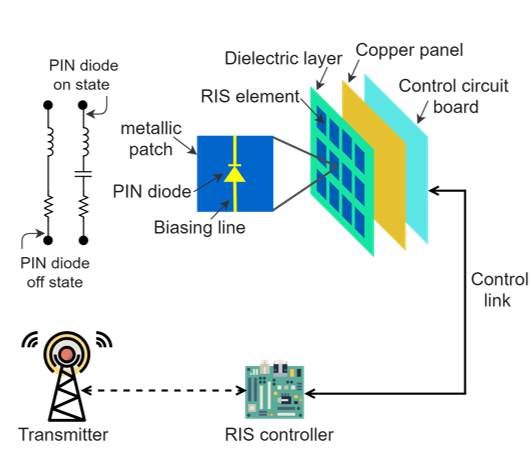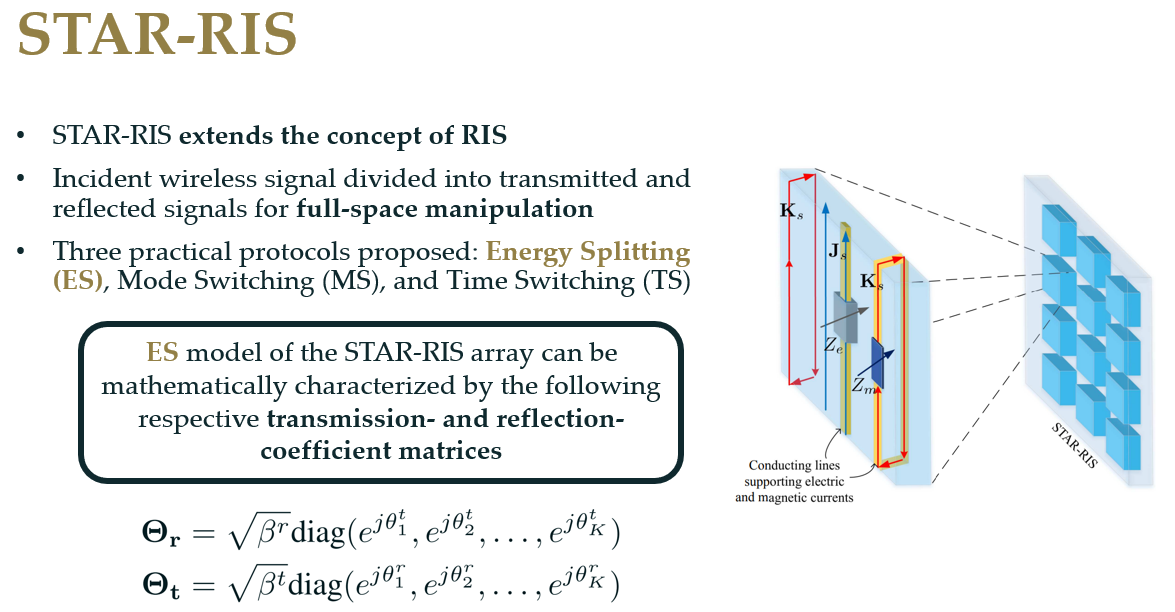The Rise of Reconfigurable Intelligent Surfaces
 Muhammad Ahmed Mohsin
Muhammad Ahmed Mohsin
Introduction:
In 6G communications, Reliable Low-Latency Communication (URLLC) is crucial, but it faces challenges like signal blockage and fading due to obstructions and environmental factors. This leads to signal degradation, affecting reliability. Additionally, 6G networks struggle with limited coverage and capacity, making it difficult to maintain consistent coverage over large areas and accommodate the growing number of connected devices. Moreover, the integration of new technologies increases the complexity of network management, requiring efficient resource allocation and optimization. Reconfigurable Intelligent Surfaces (RIS) can address these challenges by mitigating signal blockage and fading, extending coverage, increasing capacity, and enhancing resource allocation and optimization, making them essential for 6G communications.

Reconfigurable Intelligent Surfaces:
Reconfigurable Intelligent Surfaces (RIS), also known as Large Intelligent Surfaces or Intelligent Reflecting Surfaces, are innovative technologies that control the reflection of electromagnetic waves by altering the electric and magnetic properties of their passive elements. These surfaces are strategically positioned in the radio channel between a transmitter and receiver, allowing them to manipulate the propagation path of electromagnetic waves.
Goal:
The primary goal of RIS is to enhance the efficiency and cost-effectiveness of wireless communication systems by leveraging spatial multiplexing gains and high bandwidth technologies. RIS's typically consist of numerous passive elements that can be controlled individually or collectively to achieve specific objectives. These elements employ various architectures, such as PIN-diode and varactor diode, for phase and amplitude control, respectively.
Structure:
In PIN-diode architecture, an on/off switch is utilized to provide a phase difference of 𝜋 in the reflecting element. Conversely, varactor diode architecture involves adjusting the resistance in the reflecting element to control its amplitude. By reconfiguring the propagation environment, RIS's assist in optimizing communication performance and overcoming challenges like signal attenuation and interference.

STAR-RIS:
STAR-RIS, which stands for Simultaneously Transmitting and Reflecting Surface, is an advanced variant of reconfigurable intelligent surfaces (RIS) that offers enhanced flexibility and coverage compared to traditional reflecting-only RIS.
In a reflecting-only RIS configuration, both the source and the RIS must be positioned on the same side, limiting the coverage to half-space or 180°. This restriction reduces the flexibility of the system and may not be suitable for applications requiring broader coverage.
On the other hand, STAR-RIS allows for simultaneous transmission and reflection of wireless signals. This means that the incident signals can be both reflected and transmitted, providing coverage in both sides of the RIS, thereby enabling full-space or 360° coverage. This increased coverage enhances the versatility and effectiveness of the system, making it suitable for a wider range of applications and scenarios.

Mathematical Modelling:
The mathematical equations for STAR-RIS are given as:
$$\begin{align} \mathbf{\Theta_r} & = \sqrt{\beta^r}\text{diag}(e^{j \theta_1^t}, e^{j \theta_2^t}, \dots, e^{j \theta_K^t}), \\ \mathbf{\Theta_t} & = \sqrt{\beta^t}\text{diag}(e^{j \theta_1^r}, e^{j \theta_2^r}, \dots, e^{j \theta_K^r}), \end{align}$$
Challenges:
The implementation of STAR-RIS, despite its promising capabilities, poses several challenges:
Complexity of Design: Designing STAR-RIS systems involves intricate considerations due to the simultaneous transmission and reflection of signals. Coordinating the phase and amplitude adjustments for both functions requires sophisticated engineering and optimization techniques.
Hardware Constraints: Implementing STAR-RIS requires specialized hardware capable of dynamically adjusting phase shifts and amplitudes. Developing cost-effective and energy-efficient hardware solutions that can operate effectively in real-world conditions remains a challenge.
Channel Estimation and Prediction: Accurate estimation and prediction of channel conditions are essential for optimizing the performance of STAR-RIS systems. However, the dynamic nature of wireless channels, along with the presence of obstacles and environmental factors, complicates these tasks.
Interference Management: STAR-RIS systems must effectively manage interference from multiple sources, including neighboring cells and users. Coordinating the transmission and reflection patterns to minimize interference while maximizing signal strength is a non-trivial task.
Deployment and Integration: Integrating STAR-RIS into existing wireless infrastructure and deployment scenarios requires careful planning and coordination. Factors such as physical placement, regulatory compliance, and compatibility with legacy systems need to be addressed.
Conclusion:
In conclusion, the development and deployment of STAR-RIS technology hold significant promise for revolutionizing wireless communications. By enabling simultaneous signal transmission and reflection, STAR-RIS systems offer enhanced coverage, capacity, and spectral efficiency, making them well-suited for next-generation wireless networks.
Despite the considerable potential of STAR-RIS, several challenges remain to be addressed. These include the complexity of design, hardware constraints, channel estimation and prediction, interference management, and deployment considerations. Overcoming these challenges will require continued research, innovation, and collaboration among academia, industry, and regulatory bodies.
However, with ongoing advancements in materials science, signal processing, and communication technologies, the future of STAR-RIS looks promising. As researchers and engineers continue to explore new avenues for optimizing STAR-RIS systems, we can expect to see widespread adoption and integration into various wireless communication applications.
Subscribe to my newsletter
Read articles from Muhammad Ahmed Mohsin directly inside your inbox. Subscribe to the newsletter, and don't miss out.
Written by
